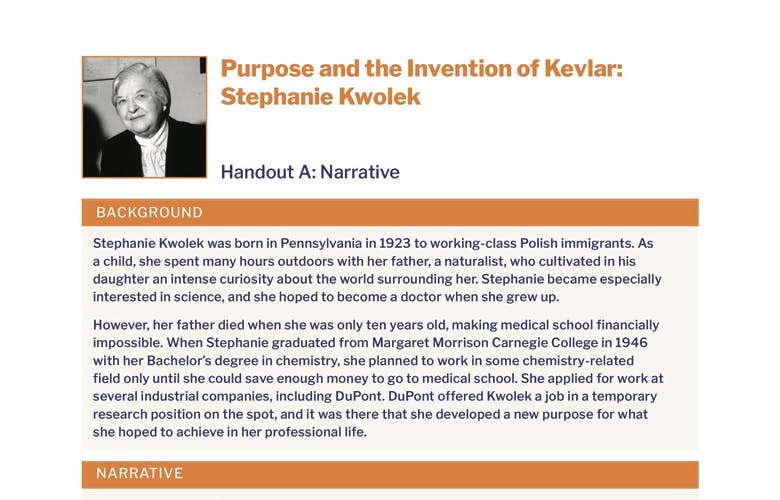Purpose and the Invention of Kevlar: Stephanie Kwolek – Handout A: Narrative
BACKGROUND
Stephanie Kwolek was born in Pennsylvania in 1923 to working-class Polish immigrants. As a child, she spent many hours outdoors with her father, a naturalist, who cultivated in his daughter an intense curiosity about the world surrounding her. Stephanie became especially interested in science, and she hoped to become a doctor when she grew up.
However, her father died when she was only ten years old, making medical school financially impossible. When Stephanie graduated from Margaret Morrison Carnegie College in 1946 with her Bachelor’s degree in chemistry, she planned to work in some chemistry-related field only until she could save enough money to go to medical school. She applied for work at several industrial companies, including DuPont. DuPont offered Kwolek a job in a temporary research position on the spot, and it was there that she developed a new purpose for what she hoped to achieve in her professional life.
NARRATIVE
Kwolek’s work at DuPont focused on fibers as she tried to develop a synthetic material that could withstand extreme conditions. Over time, she abandoned the idea of going to medical school and decided to continue her work in the chemistry lab.
In the 1960s, Kwolek and her research team were working with polymers with the goal of discovering a lightweight fiber that would be strong enough to replace the steel in radial tires. In 1964, Kwolek sought to convert a solid polymer into a liquid form but did not get the results she expected in her experiment. Instead of a clear mixture with the consistency of molasses, she ended up with a murky, thin liquid that her team suggested she discard and start over. Kwolek persuaded her colleague to run the substance through the spinneret, which would remove the liquid solvent and leave the fibers behind. She called the result “a case of serendipity” when the solution’s molecules lined up parallel, as a form of liquid crystal. Kwolek experimented with performing the spinning step at low temperatures and found that the produced fiber was extremely stiff. After repeating this result several times, Kwolek reported to her supervisors what she had discovered, patented the material in 1966, and the whole Pioneering Lab was assigned to develop commercial uses for the substance that came to be called Kevlar.
A decade later, bullet-resistant vests made of Kevlar were made available to police departments. Within a few more years, the lightweight substance was used in many other products such as military helmets, skis, camping gear, and suspension bridge cables.
The use of Kevlar has saved thousands of lives among police officers, soldiers, and others. Speaking of the breakthrough, Kwolek said, “I don’t think there’s anything like saving someone’s life to bring you satisfaction and happiness.” She did not profit from her discovery but rather signed the royalties over to DuPont. She continued to enjoy her work at the company, leading polymer research until her retirement in 1986. Throughout her career and even after her retirement, Kwolek tutored high school students and served as a consultant and mentor to young scientists, especially young women. Kwolek was the recipient or co-recipient of 17 additional patents after Kevlar, and she won many awards for her work, including the 1999 Lemelson-MIT Lifetime Achievement Award. She was inducted into the National Inventors Hall of Fame in 1994, being only the fourth woman with that honor.
Kwolek realized what contributions she could make to society through her work and tenaciously sought to achieve her purpose. Though she died in 2014, her work continues to inspire young scientists and save lives.
